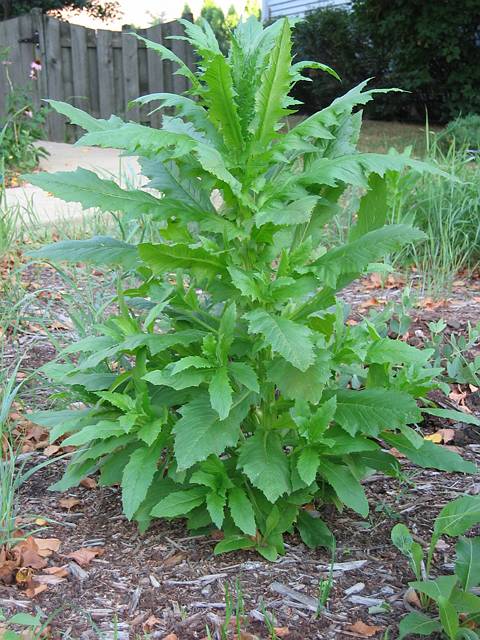
Strong-flavored Fireweed is not everyone’s favorite “mess of greens.” Photo by Icode6
With an impossible botanical name and strong aroma Fireweed is often over looked by the foraging community. Conversely the aroma is also a good identifying characteristic. As with several things in life tastes vary and many people enjoy the fireweed raw or cooked. Closely related to the Dandelion, the Fireweed locally favors the late winter or early spring. Currently you can find Fireweed from a few inches high to a couple of feet. While they do not grow in colonies often several will grow near each other. Soon the older ones will put on yellow blossoms that barely open, another identifying characteristic. Of course in greens young and tender is usually preferable and this is particularly true with the Fireweed which grows more rank as it ages. Is there a Fireweed in your gastronomic future? To read more about the Fireweed, also known as Burnweed, go here.
Our local Betony does a disappearing act every year. The plant puts on a tasty tuber in the spring months, doesn’t like the hot summers, and by fall the tubers are deteriorating. A month ago it was difficult to find any tubers but in a class north of Tampa Saturday we managed to find a few one-inch long ones. Then in Orlando Sunday we found a few more. They’ll be growing until summer hits. With a crispy texture like a radish but no heat they are a popular foraging snack and a common “pest” in most southern lawns. We spend millions of dollars every year to get rid of them… can you say “pass the salt shaker?” Other species grow in cooler climates so there’s probably a Stachys near you. Some tubers sell in excess of $150 a pound. To read more about the betony go here.
Some fruits dehydrate well, others do not. Mulberries , which are also fruiting now, an example of a fruit that is less interesting when dry. It is a way to preserve the fruit and there’s nothing wrong with that. But Mulberries loose flavor and much texture by the drying process. They are far better fresh or as confections or jelly and jam. Plums are a fruit that don’t lose anything in the drying process but in becoming prunes do change flavor and texture. Loquat are similar. Drying them creates a different product but they’re still tasty and interesting. The question is what to call these dried loquats? Dryquats? Sunquats? Squats? We are in the middle of loquat season here in Central Florida and my dehydrator is working day and night. Mine’s an industrial brute of stainless steel (and despite descriptions to the contrary it is not quiet.) Here’s 16 pounds of seeded loquats coming out of the dehydrator reduced to three pounds. If you want to read more about loquats go here. To see a short video on them click here.
In many areas of the country February and March are the worst months of the year. February usually sees more snow and cold than other months and March hints tantalizingly of spring to come. One plant that makes it through the winter in many places and also flourishes in summer is purslane, Portulaca oleracea. Probably from India but naturalized around world centuries ago, it can be found nearly everywhere except the most harshest of climates. Locally it’s putting on spring growth. Purslane is known as the world’s most nutritious green. It is full of vitamin C, omega-3 fatty acids and is some 14% melatonin. Most purslane ends up in salads or steamed as greens but it also makes a very nice fried dish particularly if you toss in some hickory or walnuts or the like. Put a little fat in a pan, add the purslane and nuts and cook over moderate heat until the purslane well-wilted and smaller leaves are browning. To read more about purslane go here.
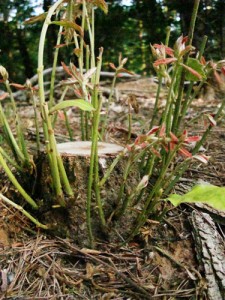
A stump coppiced to produce shoots. Photo by Eatcology
Botany Builder #25: Coppice. (KOP-is) What the word originally meant (in English) is not how it is used now. In 1534 it meant a stand of small trees, or a thicket or grove of said. Small trees and or shrubs usually have several trunks. The Southern Wax Myrtle grows in coppices. But coppice also means freely shooting or for our interests the cutting a small tree to encourage new and multiple shoots. This is done for a couple of reasons. In England it is a way to grow small wood in the past for fires (maintaining hedge rows is similar, bending a tree and cutting part way through which encourages shoot growth below the cut.) The edible Sumac is coppiced to encourage edible shoots in the spring. The base word comes from the Dead Latin word Copia meaning fullness, plentiful, a multitude. Where we hear it often in English is linked with “Cornu” (meaning horn) as in cornucopia, the horn of plenty.
The main website of this publication is Eat The Weeds And Other Things, Too. This story involves other things. The state of Montana is poised to make it legal to eat roadkill, specifically deer, elk, moose and antelope. You probably didn’t know it is illegal in most states to eat road kill, even if fresh and wholesome. As with many things you will need a permit to scrape Bamby off Montana’s roads which is what folks in Illinois do now if they have a permit. And annually Alaska turns over more than 800 moose carcasses to charitable organization to be cooked for needy people. More to the point why do states think they need to regulate road kill? Vehicles are not hunting weapons. Indeed, hitting even a small deer can cause much damage to a vehicle, fatal if you are on a motorcycle. Hitting a moose is usually a death sentence for the moose and the vehicle’s occupants. Collecting roadkill is a form of foraging. In 2011 a British man, Jonathan McGowan, was featured in the Daily Mail who not only ate road kill but it was his only source of meat for several decades. It’s also no surprise that he’s also a taxidermist. While I have not carried home big game or exotic road kill a few unflattened squirrels I’ve seen accidentally dispatched by other drivers have ended up roasted or in Brunswick Stew, which was originally made with those tree rats.
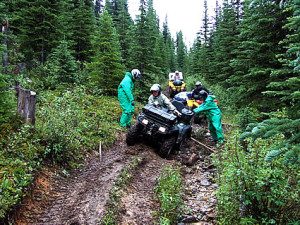
ATVs spread seeds. Photo by RidersWestMag
We know weeds seeds are spread around in a variety of ways… in and out of birds and animals; wind, water, insects, mechanical tension that flings seeds, fire and even gravity particularly with seeds that roll. Now we have to add one more means: All Terrain Vehicles. ATVs pick up and carry a lot of seeds off-trail particularly during wet weather. Studies also show that passenger cars can carry up to 135 seeds per vehicle and have spread more than 500 species. The state of Montana — remember the state above that is licensing road kill — has conducted several studies looking into the number of seeds carried, the conditions under which they are carried, the different types of vehicles, the kinds of roads and how far carried. Not surprisingly they are also studying ways to prevent seed transportation such as education, wash stations and… road closures. I wonder what qualifications one needs to join the Seed Police?

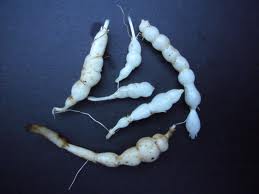
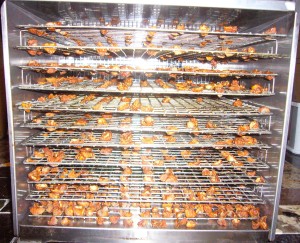
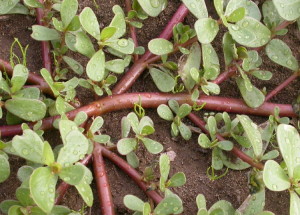


Nice job, Deane. Loved the article about foraging for roadkill in particular. I’ve often thought about it around here because we have oodles of squirrels that regularly bit the dust in the spring. I’m not quite sure what to do with them however. Do you?
Skin them carefully. Their fur can ruin the meat. Then age thema bit in the frig then cook and enjoy. Once you’ve had squirrel you’ll want it again. Very tasty.
I’m in the Bay Area, California where we have mild winters, but still have winter. Purslane disappears completely in the fall and won’t come back until until mid to late spring when truly warm weather is upon us. We use it as a marker for when to plant tomatoes and cucumbers. Usually late April through May. So my experience shows me that it actually strongly dislikes any cold.
MY first news letter …..thanks Green Deane Very interesting I loved it! Thanks
I LOVE your newsletter ! I am so glad that I found out about you here in Florida. I can’t wait to take your wild plant walk !
Thanks for this! I believe I’ve got some fireweed in my yard right now. I’m going to try it and see if I’m one of the lucky ones who like the taste.
I have heard alot of cons related to the roadkill bill in Montana. Funny thing is that here in Pennsylvania it was legal to take roadkill without a permit, still is sort of. One must obtain a slip from a Law Enforcment Officer responding to the accident. Some people were swerving to hit game then dispatching the wounded animal. However, PA’s whitetail deer population is booming more so in urban enviroments. Encounters with wildlife are becoming more and more frequent. Despite the encouragment and the free food people often scouf at you for collecting roadkill anything. I personally feel it is a waste of perfectly good food not to take your critters. One must exhibit caution however in collection and preparation much like that of any forager. Somethings may not be suitable for consumption at all.
I also roast purslanes thick stems and season with a lite sprinkle of salt and a drizzle of homemade italian dressing, much like asparagus spears.
Not only that but some idiot can run YOU over while harvesting the road kill…or should I just refer to the article on cannibalism?
mountain bikes are also spreading alot of weed seeds. in the knobby tires which all the riders want to really get dirty.
bull bars in australia are called roo bars
I’m so happy each year to find the wild purslane right in my veg garden. I always leave some for the next yr.
Love your newsletters! I look forward to them every week and I learn so much from them. I no longer look at any weed without wondering if its usefull in some way. I live in East Texas in a forested area. I only want to grow things that are edible but I am concerned about things that may become invasive. I planted an Eleagnus shrub and then found out it is considered invasive here. Guess I need to do the research first next time. There is an ap for invasive plants I found useful called, A Field Guide for the Identification of Invasive Plants in Southern Forests, Thanks again!
I LOVE Sumac.. Have for years! I’m a foraging chef and I make Za’atar.. Terrific with cherry tomaotoes and a drizzle of EVOO as tapas.. Looking forward to Knotweed season, too!
Football players in Sudan have much confidence in this “nutritional powerhouse” , Purslane or “Rigla” as they call it here – that is besides their bodies are being protected and kept healthy during the act of playing. Purslane reminds me of some basic terms in earliest practical science lessons like :imbibition, succulant and turgor pressure.It was also part of our good education to seclude a portion of the primary school area for farming by the pupils to grow vegetables important of which was Purslane. It is easy and fast to grow: scatter the seeds, water carefully and next day or the day after you receive violet seadlings. Alternatively, if you thinly cover the seeds with earth and water gently, they will peep to salute you by lifting a crust of earth; enough sunlight and moisture and these creatures are green and strong. “It is among his signs that the earth you see all barren and desolete begin to stir and sprout when We send down rain upon it. Surely He who gives it life will give life to the dead. Indeed He has power over every thing.” – holy verse. I wo’nt forget to mention the wild Purslane in my house with its smaller leaves and radiating habit of layering its shoots horizontally and keeping to grow by seeeding itself even in cracks between the ceramic tiles where there is moisture.
I pick up a lot of roadkill here in Maryland. I had an arrangement for a while with the DNR to get permission on a case by case basis. Finally they said I had too much activity for them to manage and I had to stop. They did offer a roadkill deer permit. $100 for that permit, not a chance. I do understand why they want to monitor it. If you were to get caught with an animal out of season and/or without a hunting permit, there would be questions by the law. I don’t like it, but that is the world we live in. So, I stopped getting permission and went back do picking up the filthy buggers without it. If they don’t like it they can kiss a duck.